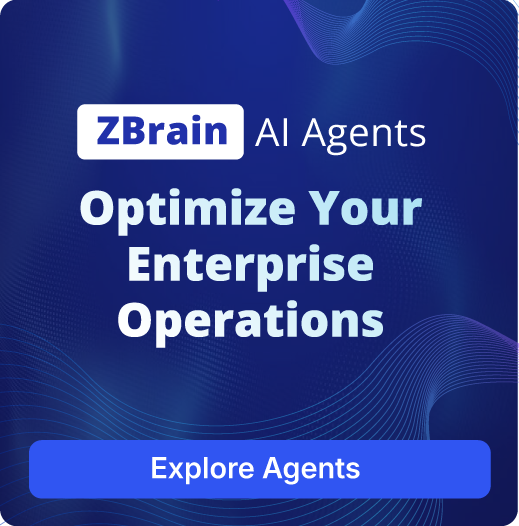Enterprise agility with low-code development: How ZBrain Builder accelerates AI application delivery

Listen to the article
Today, enterprise leaders face unprecedented pressure to accelerate digital transformation, innovate rapidly and achieve more with less effort and investment. Low-code development – especially when combined with AI – has emerged as a strategic enabler to meet these demands. Gartner predicts that by 2025, about 70% of new enterprise applications will be built on low-code or no-code platforms. This trend reflects a shift toward empowering cross-functional teams and non-technical business users to create solutions, breaking the traditional IT bottleneck.
At the same time, AI has become a C-level priority, with 83% of firms considering AI strategic, yet most lack sufficient data science talent. Combined, these trends create a strong business case for low-code AI: by democratizing AI development, companies can rapidly build intelligent apps and agents that align with core processes without waiting for scarce AI specialists. This transforms IT from a bottleneck into an enabler, positioning the enterprises for agility and efficiency.
As organizations strive to merge the speed of low-code development with the intelligence of AI, a new generation of platforms is emerging—one that empowers both technical and non-technical teams to design, deploy, and scale AI-driven applications effortlessly. ZBrain Builder is a full-stack, enterprise-grade agentic AI orchestration platform built around a low-code philosophy. It enables organizations to rapidly design, deploy, and integrate custom AI solutions—including AI-powered applications and agents—without requiring deep coding or data science expertise. With its visual development interface, prebuilt integrations and modular architecture, ZBrain Builder helps enterprises harness AI capabilities while maintaining enterprise-grade security and scalability.
This article explores how ZBrain Builder exemplifies the power of low-code development in the AI era, examining its features, architectural strengths, extensibility, limitations, and its unique role in enabling organizations to achieve optimal performance.
What is low-code development in AI?
Low-code development has emerged as a new paradigm in enterprise IT, fundamentally changing how software is delivered. Instead of traditional hand coding, low-code platforms offer visual drag-and-drop tools, declarative frameworks and ready-made components, enabling the development of applications with minimal code. This approach compresses development timelines – research shows low-code can cut development time by as much as 50% to 90% compared with conventional methods. The result is faster release cycles and quicker iterations, enabling businesses to respond to market changes with agility.
Benefits of low-code development in the enterprise
Key advantages of low-code align closely with today’s business needs:
-
Faster development cycles: Prebuilt components and templates allow teams to assemble applications rapidly rather than coding from scratch. This speed translates to quicker time to value. Organizations can roll out new products, features or process automations in days or weeks instead of months.
-
Increased productivity and reduced IT burden: By streamlining development, low-code enables IT teams to deliver more with less effort and fewer specialized resources. Business users – often called citizen developers – can also take on some app development, freeing professional developers to focus on complex or critical projects. Low-code helps address the shortage of IT talent by empowering existing teams to be more productive.
-
Democratization and business-IT collaboration: Low-code platforms open up application development to a broader audience. Domain experts and analysts who understand business processes can contribute directly by building or customizing apps through visual interfaces. This bridges the gap between business and IT, ensuring solutions align with business needs. It fosters a collaborative process where business users and developers iterate together in real time rather than tossing requirements over the wall.
-
Seamless integration of systems: Modern enterprises rely on a range of applications and data sources. Low-code platforms typically include connectors and APIs that integrate databases, enterprise applications (such as ERP and CRM) and services without heavy custom coding. This makes it easier to build end-to-end workflows that tie together siloed systems. The ability to integrate quickly with everything from legacy databases to SaaS services is a hallmark of leading low-code tools and essential for automating complex processes.
-
Scalability and performance: A common concern is whether visually built applications can scale in the real world. Today’s leading low-code platforms are cloud-native and scalable by design, supporting enterprise-grade workloads, high user counts and large data volumes. They abstract infrastructure so that apps can scale vertically (more compute) and horizontally (more users and use cases) without requiring re-architecture. A workflow prototype built quickly on a low-code tool can evolve into a mission-critical system, with the platform managing load balancing, concurrency and other backend tasks.
-
Security and governance: Early low-code tools had a reputation for enabling “shadow IT” – apps built outside IT oversight, raising security concerns. Mature enterprise platforms now include robust security architectures and controls, such as role-based access management, data encryption, audit logging, and compliance certifications. Governance features allow IT to oversee and manage what citizen developers create. In short, low-code does not mean low control. However, it is critical to evaluate platforms for enterprise-grade security, as not all are equal. Risks such as data leakage, insecure APIs or compliance violations must be mitigated through the platform’s design and governance capabilities.
Streamline your operational workflows with ZBrain AI agents designed to address enterprise challenges.
The rise of AI-oriented low-code platforms -strategic business context and ZBrain Builder
While low-code has been transforming traditional application development, a new breed of platforms is now bringing low-code to AI and machine learning. The timing is apt: Organizations see significant potential in AI to drive efficiency and innovation, but adoption remains slow. Nearly every enterprise is investing in AI pilots or tools, yet few have scaled AI across the business in a meaningful way.
Enterprise AI headwinds
Despite record AI budgets, most large enterprises are still wrestling with four structural barriers:
|
Challenge |
Enterprise impact |
Evidence |
|---|---|---|
|
Data silos and legacy integration |
Critical data is trapped in legacy systems, making it hard to feed AI pipelines or govern outputs. |
Legacy systems frequently confine key management data in silos, rendering it difficult to access and analyze. |
|
Governance and risk gaps |
Inconsistent policies around privacy, bias, and model auditability expose firms to compliance and reputational risk. |
Studies find that 47% of companies believe their AI governance policies are consistently enforced, while half deploy public AI tools without a formal policy. |
|
Scalability constraints |
Pilot models work effectively in the lab but often falter under the demands of enterprise data volumes or concurrency loads. |
Infrastructure gaps are one of the reasons pilots stall before production. |
|
Talent and skills shortages |
AI specialists are scarce; business teams lack the tools to build solutions themselves. |
Microsoft’s 2024 manufacturing survey lists data management complexity and skill gaps among the top three obstacles to industrial AI rollout. |
Without a cohesive, end-to-end platform that handles data ingestion, orchestration, security and lifecycle operations, AI efforts risk becoming fragmented proofs of concept that never scale – or worse, introducing unmanaged risk.
These challenges create a strong case for a low-code, modular approach to AI development. If business teams could assemble AI solutions almost as easily as they build a PowerPoint deck – using visual building blocks for data ingestion, model selection and workflow logic – organizations could move much faster from idea to deployed solution. Low-code AI platforms aspire to do exactly that. They abstract the complexity of working with machine learning models, data pipelines and infrastructure, allowing cross-functional teams to focus on business logic and outcomes.
This is especially powerful in the era of generative AI and large language models (LLMs). Few enterprises have in-house expertise to fine-tune or deploy the latest LLMs from providers such as OpenAI, Google or Meta, which evolve rapidly. A platform that packages these AI models behind easy-to-use components, with built-in safeguards (for example, preventing a model from hallucinating incorrect answers or leaking sensitive data), can accelerate safe adoption.
ZBrain Builder was created in this context – an agentic AI orchestration platform that applies low-code concepts to help enterprises overcome AI development and integration hurdles. ZBrain Builder provides a modular architecture with plug-and-play components for each stage of an AI solution, from connecting data sources to invoking LLMs to integrating with enterprise applications. By doing so, it addresses many pain points directly:
-
Legacy integration is handled through prebuilt connectors.
-
Scaling is supported with cloud-native deployment options.
-
Talent gaps are mitigated by enabling noncoders to build AI agents and apps.
-
Vendor lock-in is reduced by supporting multiple models, storage and deployment environments.
This approach aligns with the broader notion of enterprise composable architecture – designing systems from swappable building blocks, increasingly seen as a best practice for agility and risk management. In the AI domain, a composable platform enables enterprises to experiment and evolve their AI stack – trying new models, adding data sources and refining business rules – without rebuilding everything from scratch.
The ZBrain™ advantage: Converting vision into execution
ZBrain™ addresses these gaps with an integrated suite that spans the entire adoption curve:
-
CoI: Crowdsources and scores AI ideas across the enterprise.
-
XPLR: Quantifies feasibility, data readiness and ROI to build a board-level business case and solution design.
-
Builder: A low-code interface that turns use cases into production-grade AI agents, with connectors, LLM orchestration and guardrails.
By embedding governance, security and ROI tracking into every layer, ZBrain™ becomes the connective tissue between strategic intent and operational reality – precisely what most enterprises lack today.
Comparison of ZBrain Builder modules vs traditional AI platforms
|
Capability |
ZBrain Builder platform |
Traditional / DIY AI stack |
|---|---|---|
|
Data ingestion and connectors |
Rich library of modular connectors (REST / GraphQL APIs, webhooks, Slack / Teams, ERP & CRM adapters) for structured and unstructured sources—plug-and-play, no custom code. |
Few or no native enterprise connectors; teams hand-code ETL or deploy middleware to fetch data from each system. |
|
Knowledge Base (Vector store and Knowledge graph) |
Built-in, extensible knowledge base that stores embeddings of docs, tickets, logs, etc., enabling RAG, Knowledge Graph and vector search across the enterprise. |
No unified KB; data lives in disparate databases or file shares, forcing separate indexing or manual joins for retrieval. |
|
LLM orchestration layer |
Model-agnostic router that can invoke any LLM (GPT-4, Claude, Gemini, Llama, on-prem models), and the user can select the best model per task or policy. |
Usually hard-wired to a single cloud provider or in-house model, making swap-outs or hybrid strategies difficult. |
|
Flows |
Low-code visual interface to chain steps—data retrieval, LLM calls, decision branches, external APIs—into multi-step AI agents; versioned and reusable. |
Logic must be scripted in Python/Java or stitched together in notebooks; limited visualization, no drag-and-drop orchestration. |
|
UI, integration & governance |
Ready-made web widgets, chat interfaces, SDKs, APIs and robust governance (RBAC, audit logs, policies) for quick embedding into apps or collaboration tools. |
Often lacks packaged UIs or governance; front-end, access control, and audit layers require separate development or third-party add-ons. |
Inside ZBrain Builder: Low-code meets generative AI
ZBrain Builder is an enterprise-grade agentic AI orchestration platform – a low-code development platform specifically designed for AI agents and applications. To understand how ZBrain Builder works, it is helpful to break down its architecture and examine how its components come together to enable AI-powered solutions with minimal coding. ZBrain Builder’s design philosophy can be summarized in two key principles: modularity and orchestration. Every major function of the platform is a module that can be plugged into or swapped out of the system, and the platform orchestrates these modules – and the flow of data between them – to execute AI workflows end to end.
Architectural overview
At a high level, ZBrain Builder’s architecture comprises several logical layers or modules, each responsible for a step in the AI solution lifecycle. The table below outlines the key building blocks in ZBrain Builder’s modular stack and their roles.
|
Layer / Module |
Role in the ZBrain Builder platform |
|---|---|
|
Data integration and ingestion |
|
|
Knowledge Base |
Central repository for knowledge – typically a vector database or graph store where processed data is stored as embeddings for semantic search. ZBrain Builder’s knowledge base allows the AI agents to retrieve relevant contextual information when answering questions or making decisions. It supports extended databases, enabling efficient retrieval and context-aware AI responses. |
|
LLM orchestration layer |
A model-agnostic interface to Large Language Models (LLMs). This layer abstracts away the specifics of AI providers – ZBrain Builder can route queries to different underlying models (OpenAI GPT-4, Anthropic Claude, open-source LLMs, etc.) depending on the task or preference. It enables selection and switching of models at runtime, allowing enterprises to avoid being locked into a single AI vendor. This layer essentially “virtualizes” AI models, handling prompt formatting, model invocation, and response capture in a uniform way. |
|
Orchestration engine and AI agents |
The core automation and logic layer of ZBrain Builder. This is the “brain” that executes multi-step workflows and decision logic for the AI agents. It includes a low-code workflow builder Flow interface where users visually design the sequence of actions an AI agent will perform (e.g., calling a data source, then an LLM, then branching based on the result, etc.). They can also build multi-agent orchestration through the agent crew feature. Under the hood, the engine enforces business rules, manages workflow states, and integrates with external systems at runtime. Crucially, it also provides enterprise features such as user access control, policy enforcement (for example, ensuring that certain sensitive data never leaves the company’s environment), and a library of pre-built functions (for data processing, math, etc.) that developers can use, eliminating the need to reinvent common logic. The orchestration engine makes ZBrain™ solutions robust and enterprise-ready, handling everything from error checking to parallel task execution and logging. |
|
Interface and integration layer |
The top layer that exposes the AI capabilities to end-users and other applications. ZBrain Builder provides APIs,SDKs and embeddable UI components, enabling AI solutions built on the platform to be easily integrated into existing business workflows. For example, a company could embed a ZBrain™ -powered AI agent into their website, connect an AI agent to Slack or Teams for internal Q&A, or call ZBrain’s API from a custom frontend. |
Each of these layers interacts through well-defined interfaces. For example, an AI agent (workflow in the engine layer) may retrieve context from the knowledge base, feed that to an LLM via the orchestration layer, then send a result to an external application through an API call – all orchestrated seamlessly within ZBrain Builder. Because of its modular design, organizations can evolve each component independently (upgrade a vector database, switch an LLM provider, add a data connector) without disrupting the entire system. This provides flexibility as AI technology advances or business needs change.
One of the strengths of ZBrain Builder’s architecture is how it addresses enterprise requirements by design. The modular approach directly tackles issues of scalability, integration, security and vendor independence:
-
Scalability: ZBrain Builder components can scale horizontally and vertically. For example, if data volume increases, ingestion pipelines and the vector store can be scaled independently to handle higher throughput. Multiple AI agents can run in parallel across departments with a unified control plane, enabling seamless collaboration. The platform can be deployed on cloud infrastructure (AWS, Azure, GCP) or on premises in a distributed model, ensuring that a pilot in one team can scale into an enterprise-wide AI service.
-
Integration and openness: To avoid vendor lock-in, ZBrain Builder embraces open standards and interoperability. It exposes functionality via APIs and uses containerized microservices, allowing modules to be replaced as needed. For example, if an organization prefers a different vector database for the knowledge base, it can be integrated because ZBrain Builder’s interface is standardized. The orchestration layer supports multiple AI models, enabling hybrid strategies (one model for one task, another model for a different task).
-
Security and governance: ZBrain Builder was built with enterprise security in mind. Each workflow (agent) can be isolated to ensure sensitive data does not leak. Strict user roles and access privileges are enforced at the engine layer, and governance rules can be encoded (e.g., requiring certain data to be processed only with an on-premises model). Guardrails monitor and control AI behavior, including content filtering, to prevent inappropriate or inaccurate outputs. Compliance is supported by detailed logging and auditing. Trust is as important as capability for enterprises adopting AI at scale.
-
Maintainability and continuous improvement: By breaking AI solutions into modular components, ZBrain Builder simplifies maintenance. Teams can update one part (e.g., a new version of an LLM or a better data parser) without rewriting the entire application. Continuous delivery of updates is supported – you can refine a workflow or model and push changes in one module while the rest of the system runs. Troubleshooting is easier because modules are isolated. ZBrain Builder also includes dashboards that track performance, flag anomalies and capture user feedback to guide improvements. This focus on AI operations (AIOps) means ZBrain Builder supports the full lifecycle of AI in production, from deployment to ongoing tuning.
What makes this especially powerful is that ZBrain Builder is LLM-aware and enterprise-aware by design. For instance:
-
When connecting an LLM, users can select from supported models (OpenAI, Azure OpenAI, Google AI and others). ZBrain Builder handles API calls and authentication, so switching models later does not break workflows – prompts and data flows remain consistent.
-
The platform ensures the LLM has the right context by linking it with the knowledge base. For example, to answer customer questions using company documents, you attach the relevant knowledge base to the LLM step. ZBrain Builder retrieves relevant data (embeddings) and feeds it into the LLM using retrieval-augmented generation, grounding outputs in enterprise data.
-
Guardrails and quality checks can be inserted as blocks or settings. For example, after an LLM produces output, an “Output Checking” guardrail can verify the answer against known data. ZBrain Builder includes preconfigured guardrail features such as disallowing sensitive data outputs, reflecting best practices in AI safety.
-
Testing tools are built in. ZBrain Builder’s evaluation suite allows simulation of agents with test inputs, step-by-step inspection and automated test cases against defined success criteria. Because AI is nondeterministic, this testing framework (e.g., verifying an agent responds within a time limit or correctly handles trick questions) helps ensure reliability before deployment.
In summary, ZBrain Builder’s low-code builder functions as both the development studio and the runtime engine for enterprise AI applications. It abstracts the complexities of AI – integration, model management and data pipelines – into a user-friendly interface while enforcing enterprise-grade practices. This lowers the barrier to implementing AI-driven solutions – organizations no longer need large data science teams to begin automating knowledge work and decision processes.
Streamline your operational workflows with ZBrain AI agents designed to address enterprise challenges.
ZBrain Builder’s features and differentiators as a low-code platform
Let’s distill some of the key features of ZBrain Builder that make it a noteworthy low-code AI platform, especially compared with both traditional low-code tools and other AI development approaches:
Plug-and-play AI components
ZBrain Builder includes a library of prebuilt components and AI agents for common needs. For example, it offers pre-built agents for FAQ chatbots, document summarization, sentiment analysis, lead qualification and IT help desk support. Enterprises can deploy these out of the box or use them as templates to customize further in the Builder. This accelerates the solutions of typical use cases. It is analogous to how early low-code platforms provided template apps – such as expense approvals or customer feedback – but here with template AI solutions. By aggregating these building blocks into one environment, ZBrain Builder saves teams from reinventing the wheel or integrating separate AI services.
Low-code highlights
✓ Flow pieces – pick, place and tweak, no ground-zero builds
✓ Visual parameter tuning – such as adjusting thresholds and prompts from the UI
Model-agnostic
A key advantage of ZBrain Builder is its model-agnostic LLM layer. The platform does not tie you to one AI model or vendor. You can leverage OpenAI’s latest models, opt for Azure’s hosted versions or use an open-source model deployed in a private cloud – all through the same interface. This flexibility is crucial because the AI landscape evolves quickly; today’s best model may be surpassed in a quarter. With ZBrain Builder, enterprises can future-proof their AI strategy by swapping models or using specialized models for specific tasks.
Low-code highlights
✓ Model connector library – Add open source or a private-hosted model through a guided UI form, no custom code required
✓ Step-level model selection – In Flows, choose the LLM for each node based on requirements
✓ Conditional routing – Insert decision nodes to route requests to different models based on cost, tasks, token count or data sensitivity
✓ Bring-your-own endpoint – Register any compliant LLM endpoint with API keys and headers; ZBrain Builder handles authentication, retries and error capture
Enterprise integrations (Slack, Teams, CRM and more)
ZBrain Builder is designed to fit into enterprise workflows. It provides native connectors for data sources as well as collaboration and productivity tools. For example, companies can integrate ZBrain™ solutions with Slack or Microsoft Teams, allowing employees to interact with AI agents directly in chat. Integration with CRMs (Salesforce), ERPs (SAP) and IT service management tools means AI can act within those systems, such as logging a ticket or updating a record. Tight integration is critical for productivity because AI outputs must flow into systems of execution. ZBrain’s low-code approach (configuration over coding) lowers barriers to embedding AI in business processes.
Low-code highlights
✓ Connector library with guided OAuth – Add Slack, Teams, Salesforce, ServiceNow and other apps
✓ Flow piece for event triggers – In Flows, map events such as “new Teams message” or “Salesforce case created” to AI agent actions without scripting
✓ Webhook and REST auto-expose – Instantly turn flows into secure endpoints for system calls, without middleware
Continuous learning and improvement
ZBrain Builder supports human-in-the-loop for AI agents. Through human-in-the-loop features, users can mark answers as helpful or not, generating feedback for reinforcement learning or model adjustment. If flagged as incorrect, the agent records the feedback and adjusts its behavior. This continuous improvement aligns with best practices, creating virtuous cycles through constant monitoring and optimization. Many AI initiatives fail not at launch but in ongoing operations when models become stale. ZBrain Builder addresses this with agent dashboards, workflows and monitoring AI apps/agents to keep AI effective over time.
Low-code highlights
✓ Feedback forms auto-generated for any agent
✓ Evaluation dashboard shows accuracy, latency and drift trends graphically
Security, privacy and compliance
ZBrain Builder supports private cloud or on-premises deployment, with encryption at rest and in transit. Even when using external models, governance rules ensure that only sanitized or encrypted data is sent out. It integrates with enterprise identity systems and provides full audit trails, making it suitable for regulated industries such as finance and healthcare. Many low-code or AI services lack these features, but ZBrain Builder embeds enterprise-grade security and compliance by design.
Low-code highlights
✓ Role and permission for least-privilege access
Extensibility through code
Although low-code by design, ZBrain Builder supports “pro-code” when needed. Developers can write custom code or use the SDK – for example, by inserting Python snippets or REST API calls.
Low-code highlights
✓ Add-code block – drop a code tile into the Flow when needed
ZBrain Builder differentiates itself by being AI-centric, enterprise-grade and future-flexible. Traditional low-code platforms accelerated development but were not built for AI integration or continuous learning. Traditional AI development provided flexibility but was code-heavy and hard to scale. ZBrain Builder combines the agility of low-code with robust AI orchestration for real-world deployment, positioning it at the intersection of two major enterprise trends: low-code and AI.
Endnote
Low-code development and generative AI are two transformative forces that converge in ZBrain Builder for enterprise innovation. ZBrain Builder applies low-code principles to simplify and accelerate the deployment of AI solutions, addressing many of the challenges that have hindered adoption in the corporate world. Its modular architecture, prebuilt AI capabilities, integration flexibility and governance features provide a foundation for enterprises to experiment with, scale and govern AI initiatives under one roof.
For CXOs and technology leaders, adopting a platform like ZBrain Builder is not merely a technology upgrade – it is a strategic move that can reshape how the organization operates. It enables a shift from isolated pilots to a scalable AI factory model, where new ideas can be rapidly turned into intelligent applications that bolster the business. In an era where staying competitive requires being data-driven, automated and highly responsive to stakeholders, ZBrain Builder offers a way to embed those qualities into the enterprise operating system. Its focus on faster development, collaboration and continuous improvement aligns directly with the pace of market change – helping organizations keep up with, and even lead, that pace.
Crucially, ZBrain Builder demonstrates how a provocative idea – that even advanced AI can be made accessible through low-code – has been brought to life. This perspective challenges the notion that only highly skilled specialists can deliver AI solutions. By empowering a broader set of contributors, ZBrain Builder helps enterprises tap into the creativity and expertise of their entire organization. When evaluating platforms, technology leaders should weigh not only technical specifications but also the potential to drive a cultural shift toward agility and innovation. ZBrain Builder appears to deliver on both fronts: cutting-edge capabilities with an ethos of democratization.
In conclusion, ZBrain Builder exemplifies the next generation of low-code platforms – one that accelerates development while embedding AI into the fabric of business. It offers enterprises a path to evolve into AI-enabled, agile entities without the usual friction and delays. Low-code development with ZBrain Builder could be a pivotal step on that journey, turning the promise of enterprise AI into a tangible reality that drives competitive advantage in the digital age.
Looking to slash build times and embed AI into every workflow—without writing mountains of code?
Book your personalized ZBrain™ demo now and see how low-code development turns complex processes into secure, enterprise-grade solutions.
Listen to the article
Author’s Bio

An early adopter of emerging technologies, Akash leads innovation in AI, driving transformative solutions that enhance business operations. With his entrepreneurial spirit, technical acumen and passion for AI, Akash continues to explore new horizons, empowering businesses with solutions that enable seamless automation, intelligent decision-making, and next-generation digital experiences.
Frequently Asked Questions
What does “low-code development” mean in the context of AI, and why is it strategically important?
Low-code development replaces extensive hand-coding with visual drag-and-drop tools, declarative logic, and reusable components, streamlining the development process. In AI initiatives, this accelerates delivery by reducing development time by 50–90 percent and empowering “citizen developers”—domain experts who understand the business problem but may lack advanced programming skills. Low-code thus turns IT from a bottleneck into an enabler, helping enterprises achieve the agility benchmarks.
How does ZBrain Builder's low-code approach shorten AI delivery timelines compared with conventional coding?
A typical AI application involves multiple layers, including connectors, data preparation, model calls, post-processing, security, and monitoring. ZBrain Builder packages each layer as a reusable block. Teams can build these onto the canvas, set parameters in dialog boxes, and hit “deploy.” No custom ETL scripts, no SDK boilerplate—projects that once took months can move to production in weeks (or days for pilot scopes).
What if a low-code block can’t handle a specialized requirement—am I stuck?
ZBrain Builder offers a “pro-code escape hatch.” You can embed Python, JavaScript, or REST calls directly into a Flow via a code block. The platform automatically scaffolds authentication, error handling, and logging, so custom code remains within the governed environment. This prevents the classic low-code ceiling where teams hit a limitation and have to re-platform.
Low-code often raises concerns about “shadow IT.” How does ZBrain Builder mitigate them?
ZBrain Builder embeds enterprise governance, including workspace-level RBAC, immutable audit logs, and a live dashboard that displays every agent, owner, and the last modification date. All new agents must pass an approval process, preventing unsanctioned agents from being deployed into production and providing security teams with full visibility.
How does low-code affect testing, versioning, and release management?
Each Flow and prompt is version-controlled automatically. You can create a staging copy, run test suites with synthetic or historical data, compare metrics, and then promote to production with one click. ZBrain Builder’s built-in monitor tracks latency, accuracy, and error rates per version, and supports rollback if KPIs regress. CI/CD hooks enable the release pipeline to integrate with existing DevOps tooling.
Does the low-code interface support continuous learning for AI agents?
Yes. Feedback widgets are automatically generated for each agent’s output; user ratings and comments are collected in an Evaluation interface. A no-code retraining wizard lets you select feedback data and redeploy an updated agent entirely from the UI. Thus, continuous improvement is baked into the same low-code environment, not a separate MLOps stack.
What’s the fastest way to start a low-code AI pilot on ZBrain Builder?
Use ZBrain XPLR to identify a high-impact problem areas, clone a pre-built agent template (e.g., invoice triage, FAQ bot), connect your data via ZBrain Builder, and launch in a sandbox. Measure KPIs for a sprint, adjust thresholds or prompts as needed, and iterate.
How do we get started with ZBrain™ for AI development?
To begin your AI journey with ZBrain™:
-
Contact us at hello@zbrain.ai
-
Or fill out the inquiry form on zbrain.ai
Our dedicated team will work with you to evaluate your current AI development environment, identify key opportunities for AI integration, and design a customized pilot plan tailored to your organization’s goals.
Insights

What is an enterprise search engine? A guide to AI-powered information access
An enterprise search engine is a specialized software that enables users to securely search and retrieve information from across an organization’s internal data sources and systems.

A comprehensive guide to AgentOps: Scope, core practices, key challenges, trends, and ZBrain implementation
AgentOps (agent operations) is the emerging discipline that defines how organizations build, observe and manage the lifecycle of autonomous AI agents.

Adaptive RAG in ZBrain: Architecting intelligent, context-aware retrieval for enterprise AI
Adaptive Retrieval-Augmented Generation refers to a class of techniques and systems that dynamically decide whether or not to retrieve external information for a given query.
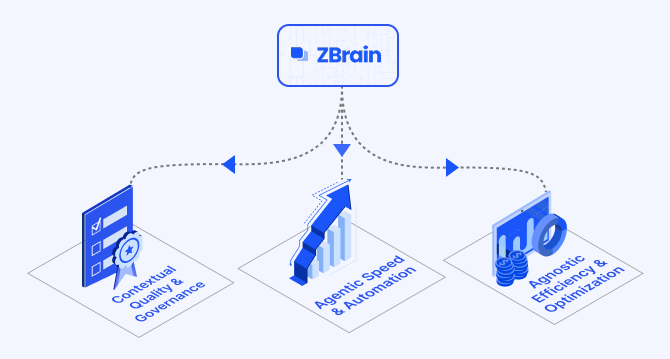
How ZBrain breaks the trade-offs in the AI iron triangle
ZBrain’s architecture directly challenges the conventional AI trade-off model—the notion that enhancing one aspect inevitably compromises another.
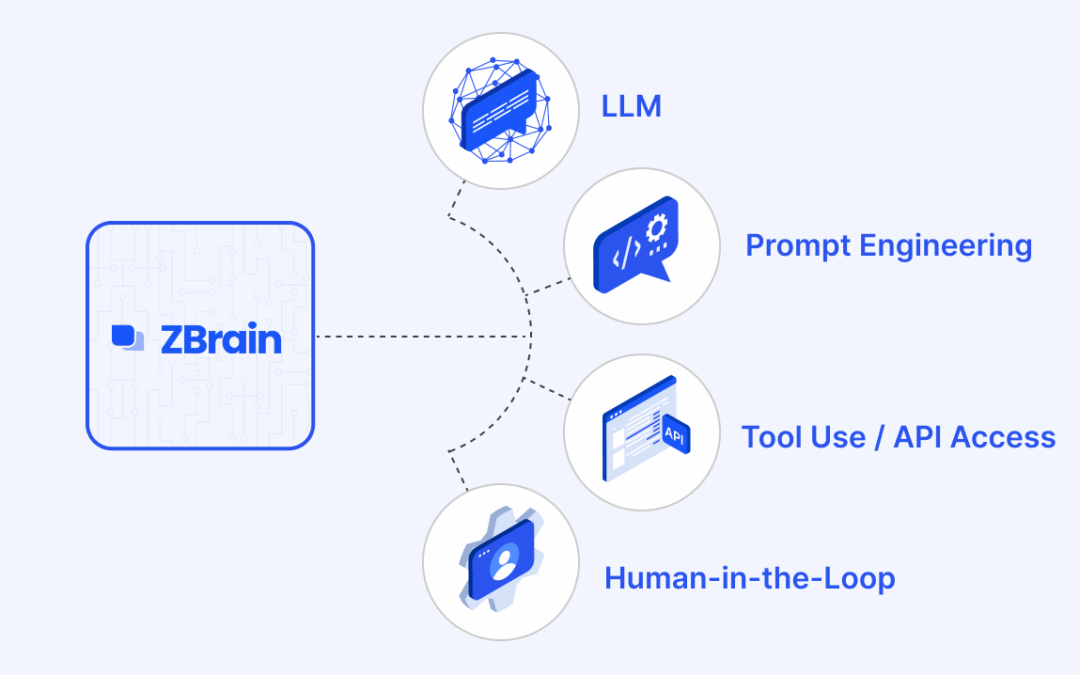
ZBrain Builder’s AI adaptive stack: Built to evolve intelligent systems with accuracy and scale
ZBrain Builder’s AI adaptive stack provides the foundation for a modular, intelligent infrastructure that empowers enterprises to evolve, integrate, and scale AI with confidence.
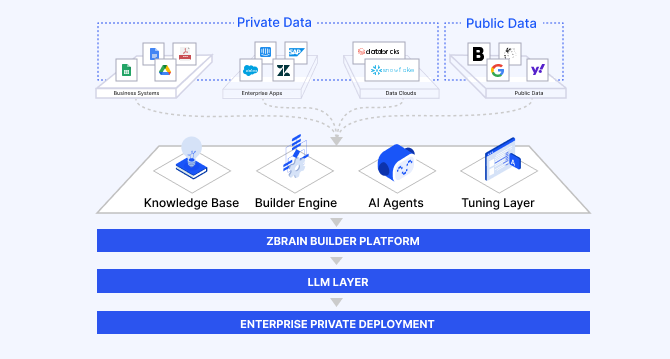
Automated AI workflows with ZBrain: Flows, LLM agents and orchestration patterns
ZBrain enables enterprises to design workflows that are intuitive for teams, efficient in execution, and adaptable to evolving business needs—transforming automation into a strategic advantage.
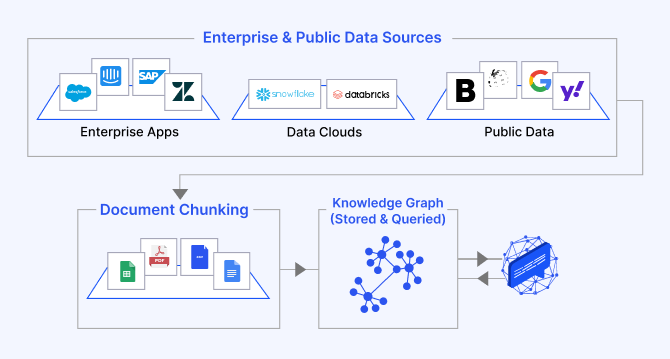
The role of knowledge graphs in building agentic AI systems: Architecture, reasoning, and ZBrain’s implementation
ZBrain Builder leverages knowledge graphs to improve contextual precision and enable reliable multi-hop reasoning in its agent responses.

ZBrain Builder: The agnostic agentic AI platform redefining enterprise AI orchestration
ZBrain Builder simplifies many aspects of AI development through its low-code interface and agnostic integration capabilities, maximizing its value depends on thoughtful planning across deployment, configuration, governance, and integration.

Agentic RAG in ZBrain: How intelligent retrieval is powering enterprise-ready AI
Discover how agentic RAG evolves AI retrieval into a dynamic, reasoning-driven workflow with ZBrain, uniting LLM intelligence and orchestration for accuracy.








